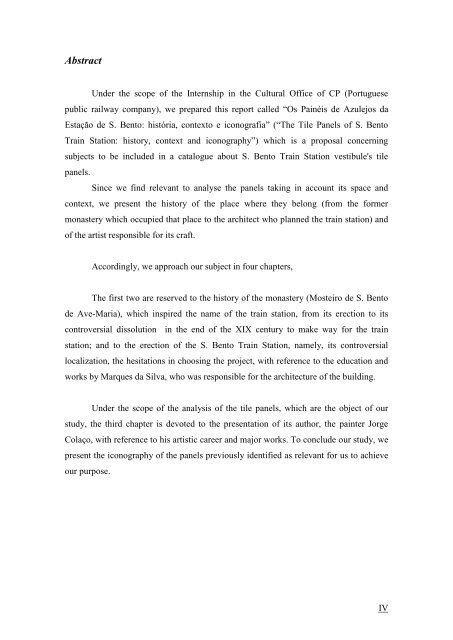os painéis de azulejo da estação de s. bento - Repositório Aberto da ...
os painéis de azulejo da estação de s. bento - Repositório Aberto da ...
os painéis de azulejo da estação de s. bento - Repositório Aberto da ...
You also want an ePaper? Increase the reach of your titles
YUMPU automatically turns print PDFs into web optimized ePapers that Google loves.
Abstract<br />
Un<strong>de</strong>r the scope of the Internship in the Cultural Office of CP (Portuguese<br />
public railway company), we prepared this report called “Os Painéis <strong>de</strong> Azulej<strong>os</strong> <strong>da</strong><br />
Estação <strong>de</strong> S. Bento: história, contexto e iconografia” (“The Tile Panels of S. Bento<br />
Train Station: history, context and iconography”) which is a prop<strong>os</strong>al concerning<br />
subjects to be inclu<strong>de</strong>d in a catalogue about S. Bento Train Station vestibule's tile<br />
panels.<br />
Since we find relevant to analyse the panels taking in account its space and<br />
context, we present the history of the place where they belong (from the former<br />
monastery which occupied that place to the architect who planned the train station) and<br />
of the artist responsible for its craft.<br />
Accordingly, we approach our subject in four chapters,<br />
The first two are reserved to the history of the monastery (M<strong>os</strong>teiro <strong>de</strong> S. Bento<br />
<strong>de</strong> Ave-Maria), which inspired the name of the train station, from its erection to its<br />
controversial dissolution in the end of the XIX century to make way for the train<br />
station; and to the erection of the S. Bento Train Station, namely, its controversial<br />
localization, the hesitations in cho<strong>os</strong>ing the project, with reference to the education and<br />
works by Marques <strong>da</strong> Silva, who was responsible for the architecture of the building.<br />
Un<strong>de</strong>r the scope of the analysis of the tile panels, which are the object of our<br />
study, the third chapter is <strong>de</strong>voted to the presentation of its author, the painter Jorge<br />
Colaço, with reference to his artistic career and major works. To conclu<strong>de</strong> our study, we<br />
present the iconography of the panels previously i<strong>de</strong>ntified as relevant for us to achieve<br />
our purp<strong>os</strong>e.<br />
IV

















